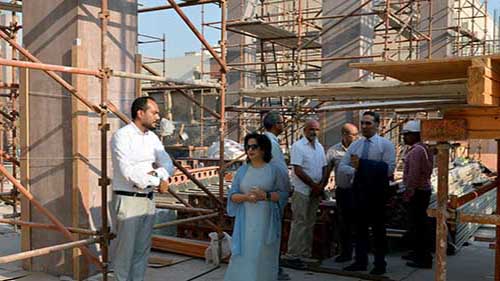03 September 2018
H.E Shaikha Mai’s Field Visit to Pearling Path Project, To Follow up latest work developments


H.E Shaikha Mai Bint Mohammad Al-Khalifa, President of Bahrain Authority for Culture & Antiquities, accompanied by BACA’s architects and staff, made a field visit, to Pearling Path project, a UNESCO World Heritage site on 3 September 2018. The purpose of visit was to inspect and to follow-up the latest developments and works planned at site.
Bahrain Authority for Culture & Antiquities has planned to inaugurate Pearling Path Visitor Center by the end of next November under the High Patronage His Majesty King Hamad bin Isa Al Khalifa, May God Protect Him. The official ceremony will coincide with the meeting of Ministers of Culture in the Islamic world in Muharraq, celebrated this year as the Capital of Islamic Culture 2018.
During her visit to the site, H.E Shaikha Mai Bint Mohammad Al-Khalifa said “ We take pride in preserving our historical universal heritage and we promote it worldwide because it is our way to introduce and present our beloved country and its bright image”. H.E added “ Pearling Path project, which tries to retell the story of the pearling economy and culture that has sustained Bahrain and the Arabian Gulf and has formed an important component of its identity, will prove once again Bahrain’s capacity and will to create sustainable development, welcoming visitors from around the globe to discover and enjoy the Kingdom’s cultural wonders”. H.E has pointed out that Pearling Path Visitor Center will be at the heart of Muharraq, a comprehensive cultural center connecting with all members of society. The activities carryout out by the center will certainly enhance Bahraini national identity and preserve the kingdom’s heritage.
Pearling: Testimony of an Island Economy’s Visitor Center is located in Muharraq’s old Suq amid historical houses. The building’s design is similar to one ceiling structure providing protection to the 1930s- built Youssif Ali Fakhro House’s fronts. The center also provides a public gathering space for local community and residents. A series of 15 air conditioners to ease the heat under the ceiling, which is supported by a magnificent pillars in total harmony with the historical décor. The building will also provide a special entry to Pearling Path between Street 10 connecting al Tujjar Street with old Moharraq suq. Pearling Path Visitor Center targets a large portion of visitors and the public, a sort of community center engulfing spaces for exhibitions, children’s corners, workshops, as well as an archive for pearling history, a library and facilities for conference holding.
Worth to mention that “Pearling: a testimony of an island economy”, a June 2012 inscribed UNESCO World Heritage List, is a 3.5km walkway through the heart of historic Muharraq, Bahrain’s second largest town. The site is a serial site consisting of 16 maritime, seashore and urban properties identified as reflecting most vividly major social, cultural and economic aspects of the grand narrative of Bahrain’s pearling activities. The nominated properties represent the culmination and final expression of some 7,000 years of pearling history in the Arabian Gulf, a tradition that fostered the creation of the grand narrative of Bahrain’s pearling economy. They include vast natural pearl-producing oyster beds located in the northern Bahraini territorial waters and seashore that was the scene of the ceremonial departure and return of Bahrain’s pearling fleet each year during the pearling era. The site has an important role in preserving the national heritage, which is a common national responsibility, pointing out the importance of Bahrain's cultural heritage in projecting the Kingdom's identity in Muharraq and elsewhere. The 16 buildings were redistributed on 11 complexes, each telling the story of a sweet memories represent the central locations and players in the pearling economy from divers, haulers, dhow captains and boat builders to folk medicine practitioners, general goods and pearl traders and grand merchants. The role and perceptions of women in the pearling economy is also paid particular attention. The buildings, surrounded by what remains of the Arabian Gulf’s pearling capital, range from family residences and reception rooms (majlis) to a family mosque, shops and storehouses.







